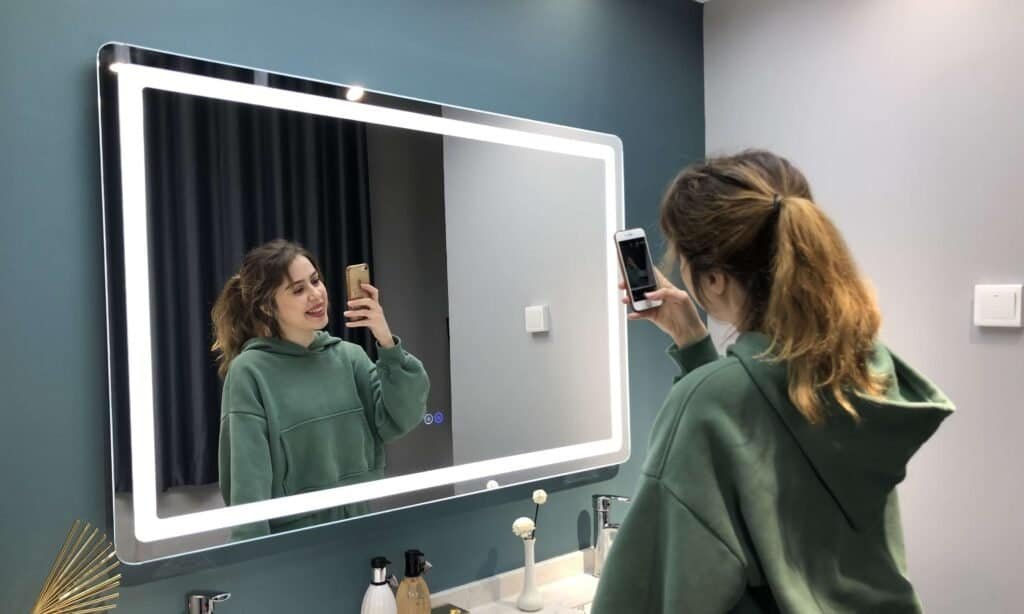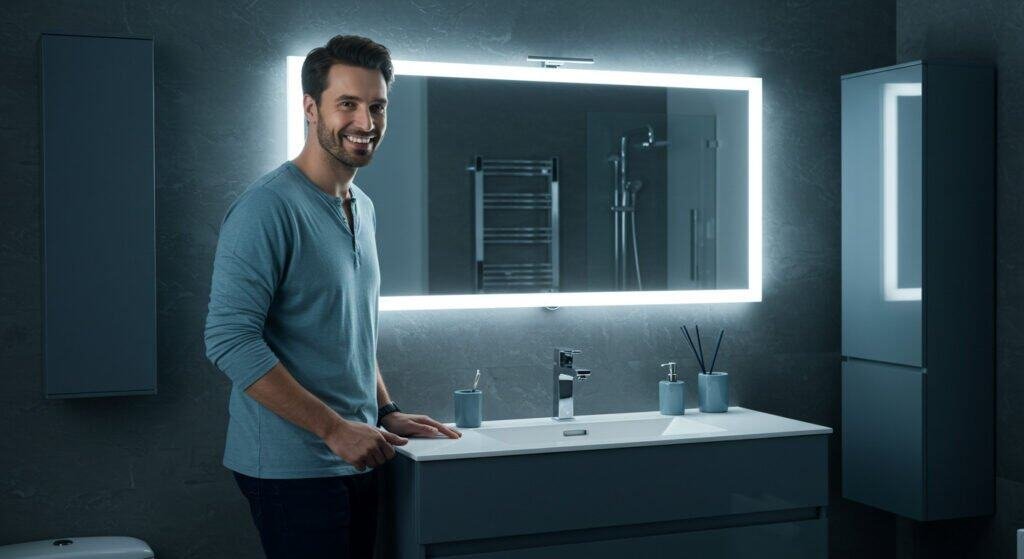What size mirror for 36 inch vanity? Choosing an incorrectly sized bathroom mirror creates visual imbalance and compromises functionality, resulting in a space that appears disproportionate and fails to meet daily grooming requirements.
For a 36-inch vanity, choose a mirror between 30-34 inches wide. This bathroom mirror size calculator recommendation ensures proper proportions while providing adequate reflection coverage. The mirror size for 36 inch vanity should maintain visual harmony without overwhelming the vanity surface.
Understanding comprehensive sizing principles ensures optimal mirror selection for both aesthetics and practical functionality in your bathroom space.
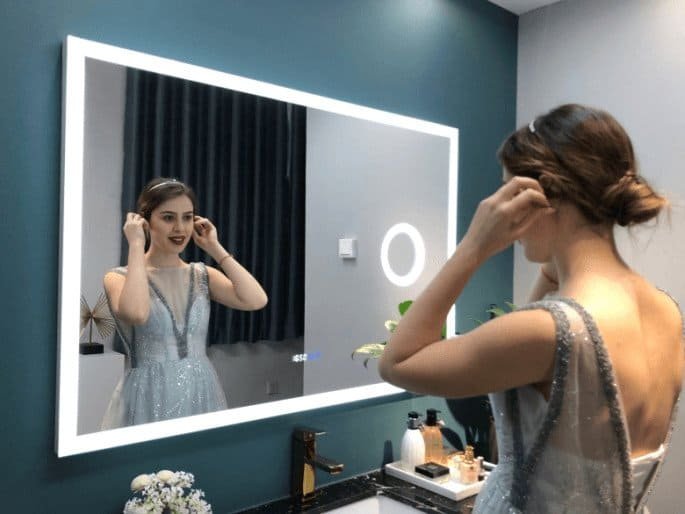
What size mirror should go over a 36 in vanity?
To determine the perfect mirror size for your 36-inch vanity, you need to understand the overall width limitations and consider the perfect height for achieving the most aesthetically pleasing proportions.
A 36-inch vanity requires a mirror width of 30-34 inches. The ideal choice is 32 inches wide, providing 2-inch clearance on each side while maintaining proper proportional balance.
The size of bathroom vanity directly influences mirror selection, with 36-inch vanities representing a popular mid-size option for single-user bathrooms. When selecting rectangular bathroom mirrors for this vanity size, consider that the mirror height should complement the width proportions.
A standard height for a vanity mirror ranges from 28-36 inches from the top of the vanity. The taller the person, the higher you’ll want to hang the mirror. A rule of thumb is to keep at least one inch of clearance between the top of the mirror and the ceiling. A 36-inch tall vanity is perfect for a standard size mirror.
How wide should a vanity light be over a 36 inch vanity?
Coordinate your vanity and mirror sizes. You want to size your vanity to the space and size of your bathroom, and you’ll want to size your mirror to the vanity. And it’s a good idea to line up the vanity light over the top of the mirror.Buffered(describing the balanced, proportional relationship between vanity, mirror and lighting)
Vanity lights over a 36-inch vanity should measure 24-30 inches wide, approximately 75% of the vanity width, ensuring even light distribution across the entire vanity surface.
The dimensions of your bathroom vanity mirror and vanity contribute to the task lighting around your bathroom sink. Specifically, the width of your lighting fixture relative to your vanity size helps with both light quality and appearance. A led vanity mirror often includes integrated lighting to simplify that coordination.
When selecting separate bathroom light mirror combinations, ensure the lighting fixture width complements both mirror and vanity proportions. Vanity lights that are too narrow create shadows and uneven lighting, while oversized fixtures can overwhelm the space and appear disproportionate to the vanity dimensions.

What size round mirror for 36 inch vanity
Round mirrors provide a softer aesthetic alternative to rectangular options while requiring specific diameter calculations to maintain proper proportions with 36-inch vanities.
For a 36-inch vanity, select a round mirror with a 28-32 inch diameter. This sizing ensures the circular shape remains proportionate without extending beyond the vanity edges.
Round bathroom mirrors create visual interest and soften angular bathroom designs. The circular format requires careful consideration of both horizontal and vertical space utilization. Modern bathroom mirror designs increasingly feature round profiles, particularly in contemporary settings.
If you’re interested in a round led mirror, you want to make sure the diameter is large enough to serve your needs, but not so big it throws off those proportional guidelines. Remember, round mirrors look best when centered in the space above the vanity. As a rule of thumb, make sure the diameter of the round mirror is no more than about 90% of the width of the vanity.
What size mirror for 36 inch vanity oval
Oval mirrors combine the elegance of round shapes with the practical coverage of rectangular formats, requiring specific width and height calculations for 36-inch vanities.
Oval mirrors for 36-inch vanities should measure 30-34 inches wide and 36-42 inches tall, maintaining the width proportions while providing enhanced vertical coverage.
Oval configurations offer versatility in bathroom mirror design, particularly when vertical space allows for taller installations. The elongated shape provides excellent coverage for grooming activities while maintaining visual softness. Lighted vanity mirrors in oval formats deliver superior illumination coverage due to their extended vertical dimension.
Look for backlit mirror options in an oval shape that will not only look great but serve a practical purpose as well. The oval shape works especially well when you have higher ceilings in the bathroom because you can play with the height without making the mirror too wide for the vanity. This allows you to maintain that visual balance we spoke of earlier.

How big should a mirror be compared to a vanity?
Understanding the relationship between mirror size and vanity dimensions ensures cohesive bathroom design that functions effectively while maintaining visual balance throughout the space.
Mirrors should measure 70-80% of the vanity width and never exceed the vanity’s total width. This proportion creates visual stability while ensuring practical functionality.
Professional designers consistently apply these proportional guidelines across various bathroom configurations. The relationship between mirror and vanity size affects the entire room’s visual balance. This vanity mirror size guide principle applies whether selecting standard size mirrors or custom options.
Double vanity mirrors for bathroom installations follow similar principles, with each mirror sized according to its corresponding vanity section. When you have a small, narrow bathroom, the key is that the mirror shouldn’t overpower the space.
However, you still want it to look good. These rules of thumb apply whether you have a 1,200-square-foot house or a 12,000-square-foot house, whether you’re doing a modest update or a full renovation. A rule of thumb is also the same whether you’re doing a Cape Cod, mid-century modern, or a new build. It doesn’t matter. These guidelines are consistent, no matter where you live or your tastes.
| Vanity Width | Recommended Mirror Width | Mirror Width Range |
|---|---|---|
| 30 inches | 24-26 inches | 21-27 inches |
| 36 inches | 30-32 inches | 28-34 inches |
| 48 inches | 38-42 inches | 36-44 inches |
| 60 inches | 48-52 inches | 46-54 inches |
How much space should I leave between the mirror and the vanity?
Now, how much space do you need between that vanity or countertop and the bottom of the mirror? You need enough space for functionality, but you also have to consider those clean, visual lines, not to mention leaving enough room for your vanity lights, faucets, and anything else you have on that countertop.
Maintain 4-6 inches of clearance between the mirror bottom edge and vanity backsplash or countertop surface to accommodate lighting fixtures and prevent water damage.
This spacing allows for vanity lights and keeps moisture from damaging the mirror edges due to splashing. The standard height for this installation is to have the center of the mirror about 60 inches off the floor, although it can vary depending on how tall you are.
Wall mirror with lights installations require additional clearance considerations to accommodate electrical connections and heat dissipation. It creates an allowance for cleaning and maintenance to ensure that the mirror is accessible for adjustments if needed. The clearance also accommodates the backsplash, and it gives the mirror a little breathing room so it doesn’t look like it’s just sitting on top of the countertop.
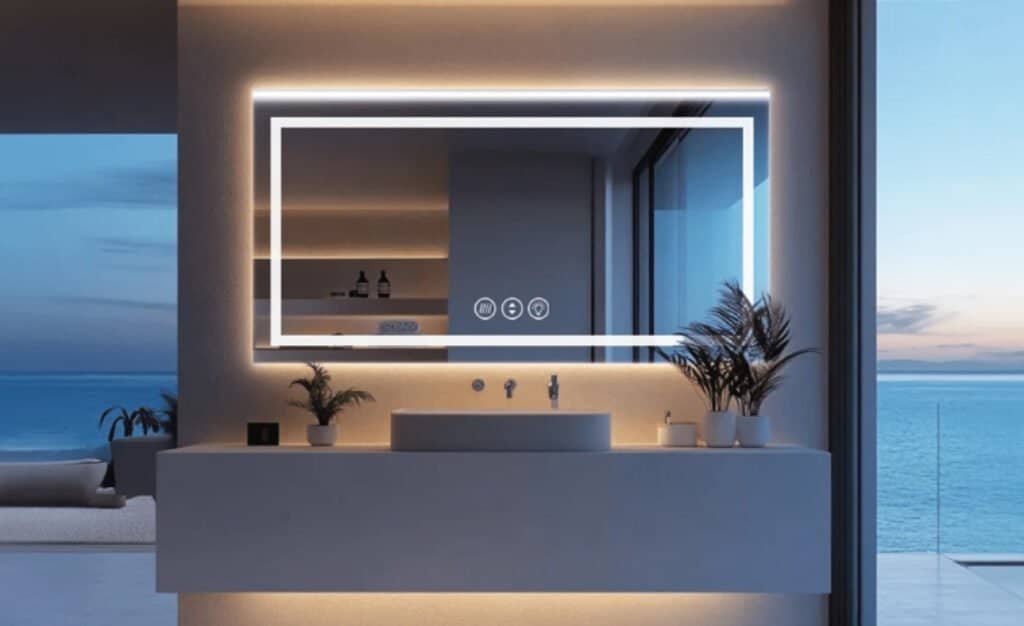
How big should a vanity light be in comparison to a mirror?
The relationship between vanity lighting and mirror size determines both illumination effectiveness and overall visual harmony in bathroom design applications.
Vanity lights should measure 75% of the mirror width, typically 24-28 inches for a 32-inch mirror, ensuring even light distribution without overwhelming the mirror proportions.
This proportional relationship ensures adequate task lighting while maintaining visual balance between all bathroom elements. Light up vanity mirror designs offer consistent lighting that eliminates shadows common with traditional fixture arrangements.
When selecting separate bathroom vanity lights to complement existing mirrors, ensure the lighting fixture width creates harmony with both mirror and vanity proportions. Lighted makeup mirror functionality becomes particularly important in bathrooms where precision grooming activities occur regularly. The lighting fixture should never exceed the mirror width, as this creates visual imbalance and can make the mirror appear undersized relative to the lighting installation.
Is a 24 mirror too small for a 30 vanity?
When evaluating mirror size for specific vanity dimensions, you can avoid a common mistake: choosing a mirror that’s either too large or too small for the space.
A 24-inch mirror is too small for a 30-inch vanity, measuring only 80% of the vanity width and failing to provide adequate reflection coverage for users.
This combination violates the minimum 70% width rule and creates visual imbalance in the bathroom space. The mirror appears disproportionately small relative to the vanity, creating an unfinished appearance that diminishes the overall design quality. Proper proportions for a 30-inch vanity require a mirror measuring 21-24 inches minimum, with 24-26 inches being the optimal range.
Bathroom mirror selections that fall below recommended proportions compromise both aesthetic appeal and practical functionality, as users receive insufficient reflection coverage for daily grooming activities. The relationship between mirror and vanity size affects the entire room’s visual balance and should be carefully considered during the selection process.
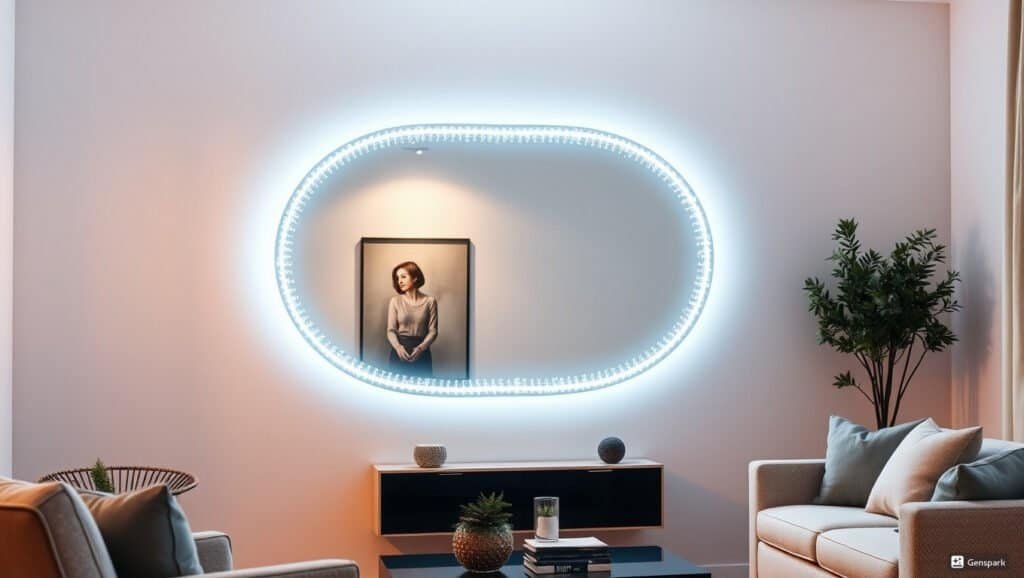
LED Mirror Advantages and Sizing Considerations
LED bathroom mirror technology does offer us more functionality, and we can still adhere to traditional sizing principles. However, when you start to add in some of these features, they may influence certain requirements with respect to dimensions, sizes, and how you install the mirror.
Led mirror options follow standard sizing guidelines but offer additional features like anti-fog, Bluetooth connectivity, and adjustable color temperature, making them ideal for modern bathroom applications.
Modern lighted mirrors for bathrooms integrate advanced technology while maintaining classical proportional relationships with vanity dimensions. These mirrors often include features such as defogging capabilities, time displays, and temperature readings that enhance daily functionality. Vanity mirror with led lights provides consistent, shadow-free illumination that traditional fixture combinations cannot match.
Lighted vanity mirrors for bathroom applications offer energy efficiency and longevity superior to conventional lighting solutions. The integrated approach of lighted bathroom mirror designs eliminates the need for separate fixture coordination while providing premium functionality.
Lighted bathroom mirrors or backlit mirror options provide ambient light in the bathroom while also offering functional task lighting. Glass mirror manufacturing can now include these technological advancements and still adhere to the basic sizing principles that will ensure they maintain appropriate size proportional relationship with the vanity.
What size mirror for a 37 inch vanity?
Custom vanity sizes like 37 inches require specific mirror calculations to maintain proper proportional relationships and achieve optimal bathroom design results.
A 37-inch vanity requires a mirror measuring 28-32 inches wide, following the standard 70-80% proportion rule while accommodating the slightly larger vanity dimension.
The 37-inch vanity represents a custom size that falls between standard 36-inch and 42-inch options, requiring careful mirror selection to maintain visual harmony. Using the bathroom mirror size calculator principles, the optimal mirror width would be approximately 30 inches, providing proper proportional balance. Led bathroom mirror options in these dimensions offer enhanced functionality while mai ntaining aesthetic appeal.
The slightly larger vanity dimension allows for marginally wider mirror options while maintaining the fundamental proportional relationships that ensure visual balance. Custom vanity sizes often require custom mirror solutions to achieve perfect proportional harmony and maximize both aesthetic and functional outcomes.

How big should a mirror be over a 48 inch vanity?
Larger vanities like 48-inch models require correspondingly larger mirrors to maintain proportional balance while serving potential double-user configurations effectively.
A 48-inch vanity requires a mirror measuring 36-44 inches wide, with 40-42 inches being optimal for single large mirrors or two 18-20 inch mirrors for double configurations.
The 48-inch vanity typically serves as a double vanity configuration, requiring mirror solutions that accommodate two users simultaneously. Double vanity mirrors for bathroom installations can utilize either one large mirror spanning the entire vanity or two separate mirrors positioned above each sink area.
Modern lighted mirrors for bathrooms in these larger dimensions often incorporate advanced features like dual lighting zones and individual controls. The mirror size for this vanity dimension must consider both the overall proportional relationship and the practical needs of multiple users. Lighted vanity mirrors for bathroom applications at this scale provide superior illumination coverage and eliminate shadows that could interfere with grooming activities for two simultaneous users.
| Vanity Size | Mirror Width | Configuration Options |
|---|---|---|
| 30 inches | 24-26 inches | Single mirror only |
| 36 inches | 30-34 inches | Single mirror recommended |
| 37 inches | 28-32 inches | Single mirror, custom sizing |
| 48 inches | 36-44 inches | Single large or double mirrors |
Custom versus Standard Mirror Options
Choosing between custom and standard mirror sizes comes down to cost, availability, and your particular design constraints, while ensuring you maintain that proportional relationship with your vanity size.
Standard mirrors offer cost efficiency and immediate availability, while custom options provide perfect sizing and unique features like specific shapes, integrated lighting, or specialized functions.
Standard size mirrors typically accommodate most common vanity dimensions and offer the advantage of immediate availability and competitive pricing. Custom mirror solutions become needed when you have specific dimensions, shapes, or integrated features in mind to achieve your design objectives. Modern glass mirror manufacturing provides numerous customization opportunities such as size, shape, edge treatments, and integrated technology features.
Room mirror ideas often incorporate custom elements to achieve unique design statements while maintaining functional requirements. The decision between standard and custom options should consider both immediate needs and long-term design goals while ensuring proper proportional relationships remain intact. Mirrors with black frame options are available in both standard and custom configurations, allowing for design flexibility while maintaining sizing precision.
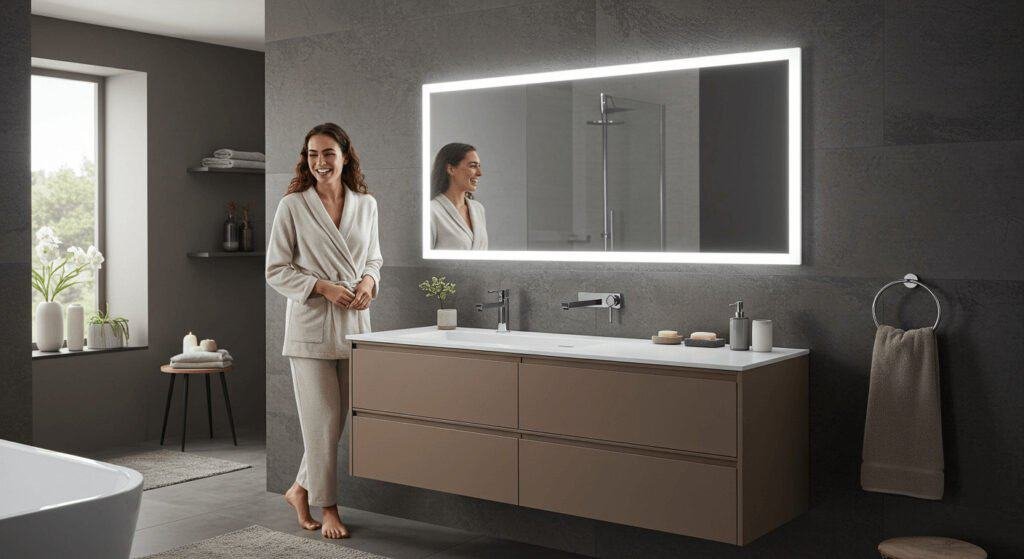
Conclusion
Selecting the appropriate mirror size for a 36-inch vanity requires balancing proportional guidelines with functional requirements to achieve optimal bathroom design and usability outcomes.
- Clik here to know What Is Copper Free Mirror?
- If you donot know how too choose the right bathroom height click here.
- Know more about LED bathroom mirror Problems
- Clik here to know why Touch Sensor Mirror Not Working
- Clik here to know What Are Standard Vanity Mirror Sizes?
- Clik here to know Why Are Mirrors So Expensive?
- Clik here to know Do LED Mirrors Need Electricity?
- Clik here to know Is a Lighted Mirror Enough Light for a Bathroom?
- Find out 10 Common LED Bathroom Mirror Problems Click Here

